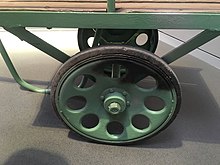Horch trailer

The Horch body car (also SAW 1/2 to Horch body car ) was the first vehicle manufactured in the Horch factory in Zwickau after the end of the war . It was mainly made from the remains of the production of chassis for the Wehrmachts vehicles Sd.Kfz. 251 and Sd.Kfz. 11 and advertised and offered with the Horch trademark, which has been used since 1924. The first Horch vehicle of the post-war period was designed as a 1/2 ton trailer for purposes of reconstruction, clearing of rubble and for agriculture.
The Horch body car was produced in unknown numbers in 1945 and 1946 and was presented to the general public for the first time on May 1st, 1946 in Zwickau under the full name "SAW 1/2 to Horch body car". "SAW" stood for Sächsische Aufbauwerke GmbH, Horch plant, Zwickau, August-Horch-Straße 21. It was available in single-axle and double-axle versions with a turntable, as well as handcarts, trailers and horse-drawn wagons or agricultural trailers with spiral suspension. It is unclear whether there were also motorized variants. Four different, non-motorized types are evidenced by image and written sources as well as two surviving copies:
- single-axle handcart with flatbed
- two-axle flatbed truck with turntable steering, cable brake acting on the rear wheels and exchangeable pulling device for manual or motor drive
- two-axle flatbed truck with turntable steering and horizontally guided pulling device for manual operation
- two-axle horse-drawn carriage with a driver's seat, handbrake, twin wheels and spiral suspension on the front and rear axles
All types had wheels on the H kl 6p chassis and had hard rubber tires. In the August Horch Museum in Zwickau , a single-axle handcart that has survived can be viewed as part of the permanent exhibition.
literature
- Werner Lang: "We Horch workers are building vehicles again". History of the Horch factory in Zwickau 1945 to 1958. Bergstraße Verlagsgesellschaft mbH, Aue 2007, ISBN 978-3-9811372-1-7 .
Web links
Individual evidence
- ↑ Permanent exhibition of the August Horch Museum in Zwickau, vehicle construction department after 1945, photo 03 "Horch workers present consumer goods and farm implements on May 1st, 1946" from the parade on May 1st, 1946
- ↑ Permanent exhibition of the August Horch Museum in Zwickau, vehicle construction department after 1945, panel photos 01 to 07, 1946, reproduction of a sales brochure for the Saxon construction works with the full name of the company and the introductory sentence: “Due to the tireless will to build and the intensity of the plant management and the Works council we bring our new production in the following production program. "
- ↑ Permanent exhibition of the August Horch Museum Zwickau, vehicle construction department after 1945, photo 05 "Trailer for agriculture with wheels from half-track vehicle Hlkl 6p"
